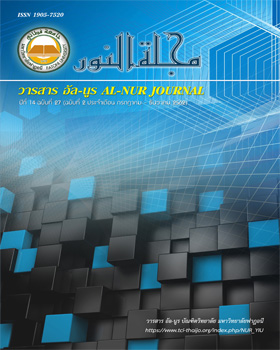Factors affecting for QR Code payment system acceptance of Mont Nom Sod Shop (Chiang Mai Branch)
Keywords:
acceptance, payment system, Quick Response Code (QR code), Mont Nom SodAbstract
The purpose of Factors affecting for QR Code payment system acceptance of Mont Nom Sod Shop (Chiang Mai Branch) was mainly to study factors affecting for QR code payment system acceptance of Mont Nom Sod Shop (Chiang Mai Branch). Research methodology was quantitative method by using questionnaire 500 respondents from customers of Mont Nom Sod Shop (Chiang Mai Branch). Research findings were factors affecting for QR Code payment system acceptance of Mont Nom Sod Shop (Chiang Mai Branch) consist of Perceived ease of use (PEOU), Perceived usefulness (PU), Convenient, fast and save time (CFST), and Attitude toward QR code (ATQC) to achieve the potential and convenient for customers to use payment system include external factors such as gender, age, education, occupation, average income, and know QR Code.
References
ชวิศา พุ่มดนตรี. 2559. “ปัจจัยที่ส่งผลต่อการยอมรับการใช้บริการพร้อมเพย์ (Prompt Pay) ของประชาชน ในเขตกรุงเทพมหานคร และปริมณฑล”. วิทยานิพนธ์มหาบัณฑิต.มหาวิทยาลัยธรรมศาสตร์.
ชำนาญ เงินดี. 2560. “การเข้าถึงและการเข้าไม่ถึงระบบการเงินของผู้ค้าชายแดนของไทย”.วิทยานิพนธ์ดุษฎีบัณฑิต. มหาวิทยาลัยเทคโนโลยีราชมงคลรัตนโกสินทร์.
ชำนาญ เงินดี และ สิทธิพร อินทุวงศ์. 2561. “การเลือกไม่เข้าระบบการเงินของผู้ค้าชายแดนของไทย”,ใน การประชุมวิชาการเครือข่ายงานวิจัยสาขาการบริหารเทคโนโลยีและนวัตกรรมประจำปี 2561 หัวข้อ “CorporateEntrepreneurship & Innovation”(ThaiTIMA The 10th Annualconference on Technology and Innovation Management) (น.74-94).กรุงเทพฯ: โรงแรมเมอร์เคียว มักกะสัน.
ดนัย ศิริบุรี ณรรฐวรรณ พูลสน และณัฐวรรณ ป้องกัน.2561. “การใช้ QR Code ในกลุ่มสินค้าเกษตร
ร้าน Modern Trade จังหวัดอุดรธานี”, แก่นเกษตร. 46(ฉบับพิเศษ 1), 894-897.
ดรุชา รัตนดำรงอักษร และชำนาญ เงินดี. 2561. “การศึกษาทักษะทางการเงินของผู้ประกอบการารค้าชายแดน กรณีศึกษาผู้ประกอบการในเขตพัฒนาเศรษฐกิจพิเศษระยะแรก”, วารสารวิชาการมหาวิทยาลัยฟาร์อีสเทอร์น. 12(ฉบับ Supplement (2561)),137-149.
ธัญญา อุตราภรณ์ และเยาวลักษณ์ เก้าเอี้ยน. 2558.“ประสิทธิภาพระบบ QR Code เพื่อควบคุมครุภัณฑ์ กรณีศึกษา กลุ่มสาขาวิชาจิตรกรรมและ ศิลปกรรม วิทยาลัยนานาชาติมหาวิทยาลัยมหิดล”, วารสารการพัฒนางานประจำสู่งานวิจัย. 2, 1-8.
ธัญญลักษณ์ พลวัน สุพรรษา กุลแก้ว และณัฐสิทธิ์ เกิดศรี. 2557. “การศึกษาพฤติกรรมการใช้เทคโนโลยีและปัจจัยที่มีผลต่อการยอมรับเทคโนโลยี QR Code ของกลุ่มประชากรในเขตกรุงเทพมหานคร”, วิศวกรรมสาร มก. 27(88),29-40.
ธนาคารแห่งประเทศไทย. 2559. รายงานระบบการชำระเงิน 2559. กรุงเทพมหานคร. 1-87.ธนาคารแห่งประเทศไทย. 2560. แนวปฏิบัติในการจัดทำ Quick Response Code (QR Code)สำหรับการชำระเงินและการโอนเงิน.กรุงเทพมหานคร. 1-15.
ธนาคารแห่งประเทศไทย. 2561. ปริมาณการชำระเงินผ่านระบบการชำระเงินและช่องทางต่าง ๆ.
จากอินเตอร์เน็ต.
https://www.bot.or.th/Thai/Statistics/PaymentSystems/Pages/StatPaymentTransactions.aspx (ค้นเมื่อ 27 กรกฎาคม 2561).
พิชชา สว่างแสง และเกตุวดี สมบูรณ์ทวี. 2559. “การยอมรับนวัตกรรมที่ส่งผลต่อการยอมรับในตัวผลิตภัณฑ์ Apple Watch ของกลุ่มผู้บริโภคGen Y เขตพื้นที่จังหวัดกรุงเทพมหานคร”, ในนเรศวรวิจัย ครั้งที่ 12: วิจัยและนวัตกรรมกับการพัฒนาประเทศ (น.1041-1051).พิษณุโลก: มหาวิทยาลัยนเรศวร.
มนต์นมสด. 2561. ร้านมนต์นมสด. จากอินเตอร์เน็ต.https://www.mont-nomsod.com/ (ค้นเมื่อ30 กรกฎาคม 2561).
ราชกิจจานุเบกษา. 2560. พระราชบัญญัติระบบการชำระเงิน พ.ศ.2560. กรุงเทพมหานคร. 1-16.
หทัยชนก วนิศรกุล. 2553. “แนวทางพัฒนาธุรกิจด้านการตลาดร้านมนต์นมสด สาขาเชียงใหม่”.วิทยานิพนธ์มหาบัณฑิต. มหาวิทยาลัยแม่โจ้.
Almehairi, M., and Bhatti, T. 2014. “Adoption of Virtual Shopping: Using Smart Phones and QR Codes”, Journal of Management and Marketing Research. 17, 1-12.
Durak, G., Ozkeskin, E., and Ataizi, M. 2016. “QR Code in Education and Communication.Turkish Online”, Journal of DistanceEducation-TOJDE. 17(2), 42-58.
Krejci, R.V., and Morgan, D.W. 1970. “Determining Sample Size for Research Activities”, Educational And Psychological Measurement. 30, 607-610.
Narayanan, A.S. 2012. “QR Code and Security Solutions”, International Journal of Computer Science and Telecommunications. 3(7), 69-72.
Pandya, K.H., and Galiyawala, H.J. 2014. “A Survey on QR Codes: in Context of Research and Application”, International Journal of Emerging Technology and Advanced Engineering. 4(3), 258-262.
Patel, J., Bhat, A., and Chavada, K. 2015. “A Review Paper on QR Code based Android App for Healthcare”, International Research Journal of Engineering and Technology (IRJET). 2(7), 1059-1061.
Petrova, K., Romanello, A., Medlin, B.D., and Vannoy, S.A. 2016. “QR Code Advantage and Dangers”, In Proceedings of the 13th International Joint Conference on e-Business and Telecommunications (ICETE 2016) – Volume 2: ICE-B (pp. 112-115). Lisbon, Portugal.
Singh, S. 2016. “QR Code Analysis”, International Journal of Advanced Research in Computer Science and Software Engineering. 6(5), 89-92.
Venkatesh, V., and Bala, H. 2008. “Technology Acceptance Model 3 and a Research Agenda on Interventions”, Decision Sciences. 39(2), 273-315.



